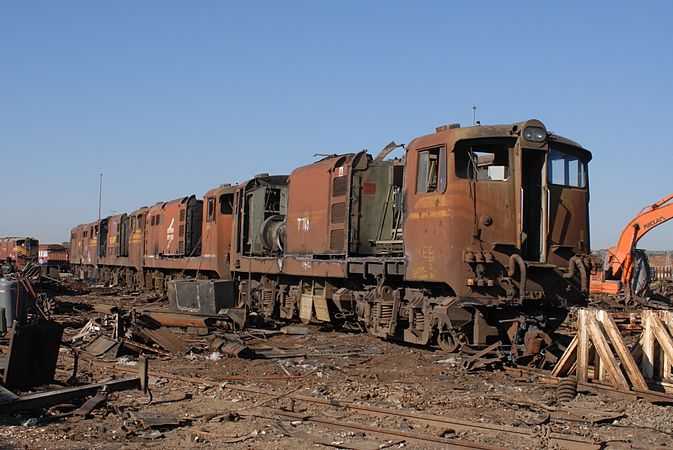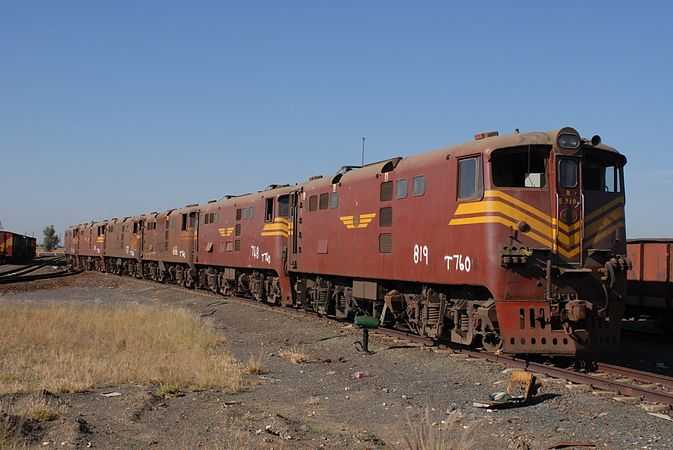South African Class 5E1, Series 3
| South African Class 5E1, Series 3 | |
|---|---|
|
No. E819 waiting in line to be cut up at Danskraal in Ladysmith, KwaZulu-Natal, 26 April 2007 | |
| Type and origin | |
| Power type | Electric |
| Designer | Metropolitan-Vickers |
| Builder | Union Carriage & Wagon |
| Model | MV 5E1 |
| Build date | 1964 |
| Total produced | 100 |
| Specifications | |
| UIC classification | Bo-Bo |
| Gauge | 3 ft 6 in (1,067 mm) Cape gauge |
| Bogies | 3.430 m (11 ft 3 in) wheelbase |
| Wheel diameter | 1,220 mm (48 in) |
| Wheelbase | 11.279 m (37 ft 0.1 in) |
| Length | 15.494 m (50 ft 10 in) |
| Width | 2.896 m (9 ft 6 in) |
| Height | 4.089 m (13 ft 5 in) pantographs down |
| Axle load | 21,591 kg (21.3 long tons) |
| Locomotive weight | 86,364 kg (85 long tons) |
| Current collection method | Pantographs |
| Traction motors | Four AEI 281 AZX |
| Transmission | 18/67 gear ratio |
| Performance figures | |
| Maximum speed | 97 km/h (60 mph) |
| Power output |
Per motor: 485 kW (650 hp) 1 hour 364 kW (488 hp) continuous Total: 1,940 kW (2,600 hp) 1 hour 1,456 kW (1,953 hp) continuous |
| Tractive effort |
250 kN (56,000 lbf) starting 184 kN (41,000 lbf) 1 hour 122 kN (27,000 lbf) continuous at 40 km/h (25 mph) |
| Locomotive brake | Air & Regenerative |
| Train brakes | Vacuum |
| Career | |
| Operator(s) |
South African Railways Spoornet |
| Class | Class 5E1 |
| Power class | 3 kV DC |
| Number in class | 100 |
| Number(s) | E721-E820 |
| Delivered | 1964-1965 |
| First run | 1964 [1] |
The South African Class 5E1, Series 3 of 1964 is a South African electric locomotive from the South African Railways era.
In 1964 and 1965 the South African Railways placed one hundred Class 5E1, Series 3 electric locomotives with a Bo-Bo wheel arrangement in mainline service.[1]
Manufacturer
Series 3 of the Metropolitan-Vickers (Metrovick) designed 3 kV DC Class 5E1 electric locomotive was built for the South African Railways (SAR) in 1964 by Union Carriage and Wagon (UCW) in Nigel, with the electrical equipment supplied by Associated Electrical Industries (AEI).[2][3]
The one hundred Series 3 locomotives were delivered in 1964 and 1965, numbered in the range from E721 to E820. UCW did not allocate builder’s numbers to the locomotives it built for the South African Railways and used the SAR unit numbers for their record keeping.[1]
Class 5E1 series
The Class 5E1 was produced in five series, the Metrovick built Series 1 and the UCW built Series 2 to 5. Between 1959 and 1969 altogether 690 of them were built, 135 Series 1, 130 Series 2, 100 Series 3, 100 Series 4 and 225 Series 5.[1][4]
With the exception of the Series 2 and 3, the series distinction between Class 5E1 locomotives was based on the different model traction motors each was equipped with, MV 281 in Series 1, AEI 281 AZX in Series 2 and 3, AEI 281 AX in Series 4 and AEI 281 BX in Series 5. The distinction between the series 2 and 3 locomotives appears to have been based on the grounds of the design of their traction motor bearings.[1][5]
Identifying features
These dual cab locomotives have a roof access ladder on one side only, just to the right of the cab access door. The roof access ladder end is marked as the number 2 end. A passage along the centre of the locomotive connects the cabs, which are identical except that Cab 2 is where the handbrake is located.[1]
The locomotive has two cut-outs on the roofline on the roof access ladder side, but an unbroken roofline on the opposite side. The Series 3, 4 and 5 locomotives can be visually distinguished from earlier models by their three small square panels on the lower sides above the battery box, compared to the two larger rectangular panels on the Series 1 and 2 locomotives. Series 4 and 5 locomotives can be distinguished from all earlier models by their one small square and one larger rectangular panels on the lower sides above the second axle from the left, compared to the single rectangular panel on all earlier models.
Brakes
The locomotive itself used air brakes, but it was only equipped to operate trains with vacuum brakes. While hauling a train, the locomotive's air brake system would be made subordinate to the train's brake system and would come into operation as the train brakes were being applied, gradually building up to its maximum of 350 kilopascals (51 pounds per square inch). While working a train downgrade, the locomotive's regenerative braking system would also work in conjunction with the train brakes.
The locomotive's air brakes would usually only be used along with the train brakes during emergencies. Under normal circumstances the train would be controlled using the train brakes alone to slow down and stop.
While the locomotive was stopped, the air brakes on each bogie could be applied independently. The handbrake or parking brake, located in Cab no. 2, only operated on the unit's last axle, or no. 7 and 8 wheels.
Traction motor bearings
The axle-hung traction motors of all earlier SAR electric locomotives, up to and including the Class 5E1, Series 1, were suspended on the axles by means of plain oil-lubricated bearings consisting of bronze shells with white metal linings. With the introduction of the more powerful Class 5E1, Series 1, considerable trouble was experienced due to flaking of the white metal linings as a result of the increased intensity of the pressure on these bearings. The use of roller bearings was investigated and one traction motor of a Class 1E was converted for trial purposes. Since satisfactory results were obtained, it was decided to equip the traction motors of the subsequent UCW-built Series 2 and later locomotives with roller-type suspension bearings.[5]
On the Class 5E1, Series 2 locomotives the arrangement consisted of a self-aligning spherical roller bearing at the pinion end and a parallel roller bearing at the commutator end of the traction motor. The roller bearings were grease-lubricated and were carried in a split cannon box to which the traction motor was attached by means of two clamps that engaged cylindrically-machined seatings on the outside of the housing. The roller-type suspension bearings required little attention other than the replenishment of the grease when the wheels were removed for tyre-turning.[5]
When orders were placed for the Class 5E1, Series 3 and later models, the specifications made provision for roller suspension bearings incorporating a lip-type cylindrical roller bearing to replace the self-aligning spherical roller bearing at the pinion end, and alternatively for tapered roller bearings at both ends. Since the external dimensions of the bearing-housings would remain the same, the traction motors would still be freely interchangeable.[5]
Service
The Class 5E1 served on all 3 kV DC electrified mainlines country-wide for almost forty years, but by the early 2000s the Series 3 locomotives were all retired. None are known to have survived.[3]
Livery illustrated
The main picture shows number E819 in the SAR Gulf Red and whiskers livery that was introduced in 1960 and that the whole series was delivered in.[3]
-

No. E742 being cut up at Danskraal, Ladysmith, 26 April 2007
See also
- Numbering and classification: Electric locomotives
- List of South African locomotive classes
- South African Class 5E1, Series 1
- South African Class 5E1, Series 2
- South African Class 5E1, Series 4
- South African Class 5E1, Series 5
- South African locomotive history
References
|
- ↑ 1.0 1.1 1.2 1.3 1.4 1.5 South African Railways Index and Diagrams Electric and Diesel Locomotives, 610mm and 1065mm Gauges, Ref LXD 14/1/100/20, 28 January 1975, as amended
- ↑ "UCW - Electric locomotives" (PDF). The UCW Partnership. Archived from the original (PDF) on 12 October 2007. Retrieved 30 September 2010.
- ↑ 3.0 3.1 3.2 Middleton, John N. (2002). Railways of Southern Africa Locomotive Guide - 2002 (as amended by Combined Amendment List 4, January 2009) (2nd, Dec 2002 ed.). Herts, England: Beyer-Garratt Publications. pp. 50–51, 53.
- ↑ Paxton, Leith; Bourne, David (1985). Locomotives of the South African Railways (1st ed.). Cape Town: Struik. p. 128. ISBN 0869772112.
- ↑ 5.0 5.1 5.2 5.3 SAR&H Annual Report 1963-64, Research - Mechanical engineering. p. 73.
